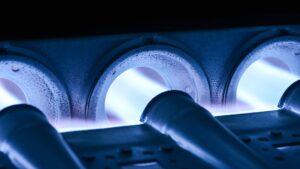It’s a question we receive all the time: will a gas furnace work without electricity? It won’t, and there are a few reasons why.
Before we delve into the three main components of your furnace that require electricity, we want to make it clear that if you’re experiencing any problem with your furnace’s electrical system, do not try to repair it on your own.
Without the proper knowledge, safety equipment, and experience, it’s extremely dangerous to toy with electrical wiring and components on your own. Now let’s talk about where your furnace receives and uses electricity.
You Have to Power Your Blower Motor
Your furnace heats air and separates the dangerous gases from it. Those gases go into the heat exchanger, and the warm air is sent to the blower motor.
Then it’s your blower motor’s responsibility to propel the air through the ventilation system. That blower motor can’t operate off of gas; it has to be powered with electricity.
Additionally, your blower motor has a sensor that also relies on electricity. We’ll talk about that in a moment, but rest assured it plays a major role in your system’s safety.
The Ignition System Runs on Electricity
Gas furnaces no longer use standing pilot lights to ignite the burners. Instead, they use an electronic ignition system. Instead of keeping a pilot lighting burning 24/7, an electronic ignition system lights the pilot as needed (known as an intermittent pilot) or lights the burners directly with an electric spark (known as a hot-surface ignition system) so you aren’t wasting money on the furnace ‘round the clock.
Electronic ignition is not only more energy-efficient, but it’s also safer for everyone. The trade-off is that if there’s no electricity, there’s no way to fire up your furnace. In case you’re curious, this is safer for your family because a furnace that’s completely overwhelmed will trip the circuit breaker instead of continuously running. With no electricity to light the pilot, you stop an overworked furnace and prevent it from causing problems.
Safety Sensors
Remember your blower motor? On the blower, there’s a sensor that tells it how fast to go, and it’s there for a good reason. If you’ve ever used a standing fan before, you know that air enters from the back, the blades spin fast, and cool air pushes out from the front. If your blower motor blows too fast, it cools the air instead of simply pushing it, just like a fan on a hot day does to the warm air inside your home.
This isn’t just horribly inefficient, but it results in longer wait times to heat your home, and it puts unnecessary strain on your furnace since it needs to run longer. This sensor keeps the fan speed where it needs to be for optimal efficiency.
You Still Need Electricity for Your Furnace
At the end of the day, you’re always going to need electricity in your furnace to get it going. The ignition source requires it, as do the sensors and the blower fan.
Without these, you not only lack the ability to run your furnace, you also lack critical safety features. If you have any problem with your furnace’s electrical system, don’t hesitate to make a call to a professional today.
Contact Bartels Heating & Cooling today to schedule your furnace’s electrical repair or any other furnace repairs today.

